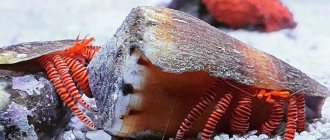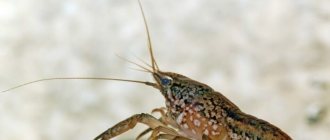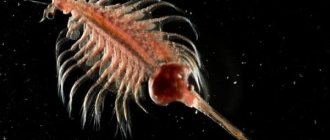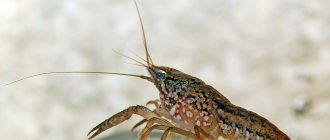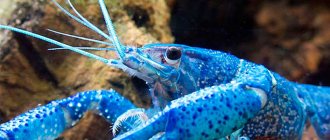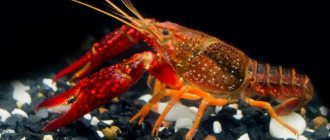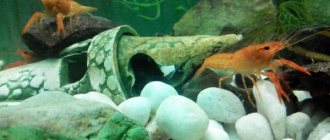Marine crustaceans
Simplicity of content:
Latin name: Pagurus Bernhardus
Lifespan: up to 11 years
Maximum size: 15 cm.
Average cost: from 500 rub.
The hermit crab belongs to the class of crustaceans. There are many species, each of which deserves attention, but not all hermits are suitable for keeping in an aquarium. And those that are suitable require some knowledge from the owner. Which ones? Let's find out in the article.
Appearance and structure
The size of the hermit crab is from 2 to 15 cm, determined by its species. The description of the appearance and structure of the arthropod is quite unusual. The body consists of: head, legs, torso, mustache and claws. The latter are located near the head. The claw on the right is larger than the left. It is used to cover the residential entrance. The left one obtains food. The legs are located next to the claws, with their help the crayfish moves.
The structure of a hermit crab is easier to see in the picture. Because in real life, this arthropod is always in a hurry somewhere and does not allow you to take a closer look at itself.
The body (in the front part) is covered with a chitinous layer i.e. shell. The flimsy back is not covered by anything. That's why the cancer hides her in the house. It is difficult for him to survive without a shell. It is fixed with the help of small hind limbs. Crayfish make their home in the shells of various mollusks. For convenience, arthropods always choose shells larger than their body. Due to the fact that crayfish are constantly growing, there is a need to periodically look for new housing.
The appearance (including color) of the hermit is determined by age and species. It can be pink (different shades), blue, red, purple.
Biology
Shells and shell competition
When hermit crabs grow, they require large shells. Since suitable intact gastropod shells are sometimes a limited resource, vigorous competition often occurs among hermit crabs for shells. The availability of empty shells at any given location depends on the relative abundance of gastropods and size-matched hermit crabs. An equally important issue is the population of organisms that prey on gastropods and leave the shells intact. Hermit crabs kept together may fight or kill a competitor to gain access to the shell they favor. However, if the crabs change significantly in size, the occurrence of fights over empty shells will decrease or remain non-existent. Hermit crabs with also small shells cannot grow as fast as those with well-fitting shells and are more likely to be eaten if they cannot retract completely into the shell.
When a hermit crab grows in size, it must find a larger shell and leave the previous one. This habit of living in a used shell gives rise to the popular name "hermit crab", in analogy to a hermit who lives alone. Several species of hermit crabs, both terrestrial and marine, use vacancy chains to find new shells; when a new, larger shell becomes available, the hermit crabs gather around it and form a sort of queue from largest to smallest. When the largest crab moves into a new shell, the second largest crab moves into the newly vacated shell, thus making its previous shell accessible to the third hermit crab, and so on. Hermit crabs will often "gather" on a hermit crab with what they feel is the best shell, where they will actually rip its home (the shell) away from it and then compete for it, and each will eventually take it over.
For some large marine species, maintaining one or more sea anemones on the shell can deter predators. The sea anemone benefits because it is in a position to consume the hermit crab's food fragments. Other very close symbiotic relationships are known from encrusting bryozoans and hermit crabs forming
bryoliths.
Development and reproduction
Species of hermit crabs range in size and shape from species with a scute only a few millimeters long to Coenobita brevimanus
, which can live 12–70 years
and can approach the size of a coconut. Shell of a smaller hermit crab Birgus latro
(coconut crab) is the largest terrestrial invertebrate in the world.
The young develop step by step with the first two (nauplius and protozoea) occurring in the egg. Most hermit crab larvae hatch in the third stage, zoea. In this larval stage, the crab has several long spines, a long, narrow abdomen, and large, banded antennae. Several zoeals moult, followed by the final larval stage, megalopa.
Popular types
There are hundreds of varieties of hermit crabs known. By and large, they differ only in color, less often in size. Among aquarium lovers who choose arthropods by color, the following representatives are considered the most popular.
Hermit crabs: blue-striped, golden-spotted, orange-striped, red-legged.
In the wild
Local residents and tourists often encounter the following crayfish on the coast. These freedom-loving arthropods are not suitable for aquarium keeping, but you must enjoy their beauty!
Diogenes
Can be found on the coast of Anapa. It is small in size - about 3 cm. Body color is pink or grayish. The legs, eyes, antennae of the organs of smell and touch extend beyond the shell.
Clibanarium
Inhabits rocky terrain. Usually lives in the voluminous shells of rapans. They differ in orange, red (the color of coral reefs) color.
Palm thief
Uses shells only at the beginning of life. Adults reach a length of 40 cm, body weight - about 4 kg. Their meat is used for cooking. Crayfish live on land on the islands of the Indian Ocean.
Paguristes puncticeps
The white-spotted hermit crab lives in the Caribbean region. In nature it grows up to 12 cm; in an aquarium, as a rule, it reaches smaller sizes.
Outwardly, they are distinguished by red-brown or brown carapaces with white tubercles scattered over them (because of which, in fact, crayfish received their name), the claws and walking limbs are also colored in the same tone. Bright blue eyes amaze with their beauty. The claws are almost identical in size.
In general, in its behavior and food preferences, it is very similar to Dardanus.
Creation date: 02/08/2017
Health and life expectancy
At the larval stage, hermits often become food for sea inhabitants. In the adult life period, survival rate is higher, thanks to the life-saving house. The most difficult moment of life is moving to a new home. Then the soft body has no protection and the hermit can easily become prey for another animal. It happens that cancer drives a weaker relative out of the home, and itself takes his place. In addition, hermits select tube and bottle caps, pieces of Lego and other human garbage as a home. But even with a house, a hermit cannot feel completely safe. After all, squids and octopuses can easily destroy a crayfish shell with their jaws. The lifespan of these arthropods reaches 10-11 years.
Hermit crabs face to face.
Heating a prepared aquarium
Since hermit crabs are considered tropical inhabitants, the optimal temperature for them ranges from 27 degrees. Most often, the apartments of the average house are not heated enough for them, so install a bottom heater that is attached to the bottom from the outside, this is clearly visible in the photo. It is low-power and gives an increase of only 5 degrees, but this is quite enough. It is not advisable to use tungsten filament because it dries the air quickly. It is ideal if you can create different temperature conditions in different sides of the aquarium.
Content requirements
A comfortable stay for one hermit crab can be ensured with the help of an aquarium, the size of which is at least 40 liters. And more, depending on the size of the adult animal and the number of living organisms living in it. Water temperature is at least 26 degrees. A lower one will provoke diseases, and a high one will speed up metabolism too much and lead to premature aging. Acidity requirements: 8 pH. Salinity 35-37.
Hermit crab in an aquarium.
Place fine sea sand at the bottom of the aquarium in a layer of at least 12 cm. Other fillers can damage the delicate body of arthropods. It is important that the sand be sea sand, because any other sand will not be able to provide the ecosystem with the necessary minerals. Hermits also enjoy climbing and playing. In this regard, the presence of natural pebbles and toys in their home is required. As the hermit grows, it will need a new home, so you should also add several shells of different sizes to the aquarium.
Neighborhood
It happens that crayfish, while looking for a home, offer their relatives to exchange shells. They tap their claws on the neighbor's house. If the proposed exchange suits the latter, then the crayfish exchange shells. Otherwise, they diverge or enter into confrontation, you never know.
Hermit crabs do not tolerate loneliness at all (despite their name). For this reason, there should be two or more individuals in the aquarium. Practice shows that representatives kept in captivity are very calm. It is very rare to see them aggressive.
But snails have almost no chance of surviving with such neighbors. The shells will be appropriated and their previous owners eaten.
In most cases, the hermit coexists peacefully with fish and shrimp.
However, there is a creature whose proximity brings benefits to cancer - sea anemone. The symbiosis of the hermit and sea anemone is fascinating! He carries her on his shell and feeds her, and she protects him with poisonous tentacles!
A hermit, moving to a new house, carefully takes his neighbor with him!
Nutrition
Feeding arthropods rarely causes problems. This is due to the fact that these animals eat any kind of food. They are scavengers ; in most cases, the remains of fish food falling to the bottom are sufficient. If you want to pamper your pet, offer him seafood: shrimp, squid, octopus, dry seaweed. Food must be pre-chopped. In addition to collecting “edible” garbage, the hermit rids the aquarium of detritus, lower algae and cyanobacteria.
Crayfish should never be overfed.
Hermits are very smart animals. They quickly find their bearings when feeding other inhabitants of the aquarium (for example, fish). At the right moment, the crayfish will be in the feeding area to pick up the leftovers.
Description
Most species have long, spirally curved bellies, which are soft, in contrast to the hard, fossilized bellies seen in related crustaceans. The vulnerable belly is protected from predators by a salvaged empty seashell carried by a hermit crab into which its whole body can renounce. The shells most commonly used by hermit crabs are sea snail shells (although the shells of bivalves and scaphopods and even hollow pieces of wood and stone are used by some species). The tip of the hermit crab's abdomen is adapted to squeeze tightly onto the axis of the snail's shell.
Most species are aquatic and live in variable depths of salt water from shallow reefs and shorelines to the deep sea floor. Tropical areas host some terrestrial species, although even those have aquatic larvae and therefore need access to water for reproduction. Most hermit crabs are nocturnal.
Several species do not use caravans and inhabit immobile structures left by polychaete worms, vermetid gastropods, corals and sponges.
Interesting Facts
What owners don’t use as a house for hermit crabs!
- The hermit completely eats small fish (down to the bones) in just a few hours.
- They are active both during the day and at night. All the time is spent searching for food.
- Other representatives of crustaceans and polychaete worms can live in the crayfish shell. It is interesting that he does not touch his own, but eats others with pleasure.
- Hermits are called reservoir orderlies. This can be explained this way: they eat everything that comes their way. Thanks to this interesting fact, their habitats are always very clean.
- Crayfish meat is white in color, tender and pleasant in taste. Its weight is 20% of body weight.
- Molting turns an ordinary hermit into a helpless animal. It happens several times in the first two years of life, and then many more times during the remaining period of existence.
- Crayfish respiration occurs through the skin's gills. To maintain oxygen exchange, he needs to periodically be exposed to fresh air.
- The eyes are located on stalks. This makes it possible to stretch them, which regulates vision.
Hermit crabs are real beach cleaners. Thanks to their lifestyle, they rid the natural environment of organic carrion. Living in aquariums, as the owners note, they bring order to their glass houses. Hermits destroy cyanobacteria, detritus and other harmful substances in an artificial reservoir. This means they will not only decorate, but also clean your aquarium!
Lifestyle of a hermit crab
In its natural environment, the hermit crab has many enemies - squids, octopuses, and mollusks. A solid shell house does not provide complete protection. For the sake of safety, many individuals enter into symbiosis with sea anemones, dragging both the shell and their neighbors with them.
The crustacean is constantly growing and is forced to periodically change its shell. It is necessary to borrow a protective shell from gastropods; in the absence of a suitable dwelling, any capacious hollow objects are used.
Hermit crabs exchange houses by tapping on their favorite shell. If consent to move is received, the individuals pat each other on the claws, and the previous occupant leaves the shell. Refusing the exchange, the animal hides deeper or takes a threatening pose. Forced “eviction” of a weaker animal is practiced.
The crustacean spends its entire life on the move, looking for food. They eat algae, pieces of dead fish and shellfish, fruits, and coconuts.



